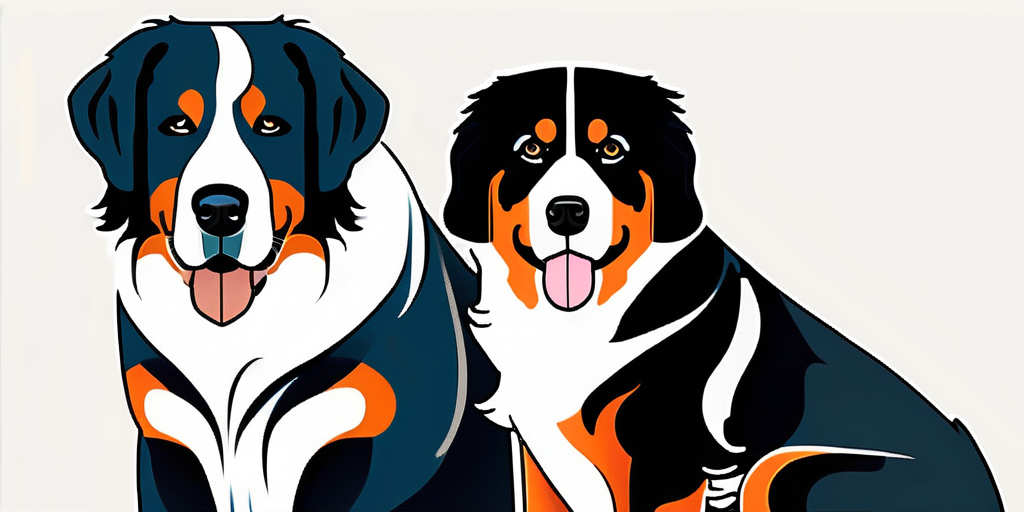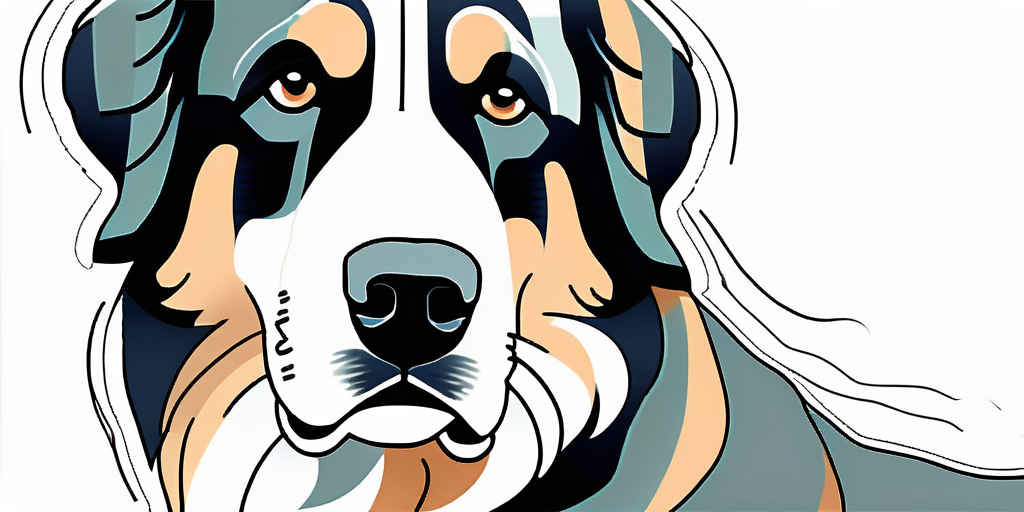If you’re considering getting a new dog and are torn between the Great Pyrenees and the Bernese Mountain Dog, it’s important to understand the unique characteristics of each breed before making a decision. In this article, we will compare the two breeds in terms of their origins, physical characteristics, temperament, health, and training needs. By the end of this guide, you’ll have a better understanding of which breed may be the best fit for you and your lifestyle.
Understanding the Breeds
Origins of the Great Pyrenees
The Great Pyrenees, also known as the Pyrenean Mountain Dog, originated in the Pyrenees Mountains, which is located between France and Spain. These majestic dogs have a rich history dating back to ancient times when they were prized for their ability to protect livestock from predators such as wolves and bears. Their thick double coat provided insulation against the harsh mountain climates, while their large size and fearless demeanor made them formidable guardians.
Great Pyrenees are known for their independent nature and strong protective instincts. They are gentle and affectionate with their family, but wary of strangers, making them excellent watchdogs. Despite their imposing size, they are surprisingly agile and graceful, able to traverse rugged terrain with ease.
Origins of the Bernese Mountain Dog
The Bernese Mountain Dog hails from the Swiss Alps and has a long history of working alongside farmers and herders in the region. These striking dogs were valued for their versatility and strength, excelling in tasks such as herding cattle, pulling carts loaded with goods to market, and standing guard over their owner’s property.
Known for their friendly and gentle disposition, Bernese Mountain Dogs are beloved for their affectionate nature and devotion to their families. Despite their size, they are known to be excellent with children and other pets, making them ideal companions for households seeking a loyal and loving canine friend.
Physical Characteristics
Size and Weight Comparison
When comparing the Great Pyrenees to the Bernese Mountain Dog, there are noticeable differences in size and weight.

- The Great Pyrenees is a large breed, typically weighing between 85 to 115 pounds (38 to 52 kilograms) for males and 75 to 90 pounds (34 to 41 kilograms) for females.
- The Bernese Mountain Dog is also a substantial breed, weighing between 80 to 115 pounds (36 to 52 kilograms) for males and 70 to 95 pounds (32 to 43 kilograms) for females.
It’s important to note that individual dogs may fall outside of these weight ranges, so always consider the specific size of the dog you’re interested in.
When it comes to height, the Great Pyrenees typically stands between 27 to 32 inches (69 to 81 centimeters) at the shoulder for males and 25 to 29 inches (64 to 74 centimeters) for females. In comparison, the Bernese Mountain Dog is slightly shorter, with males ranging from 25 to 27.5 inches (64 to 70 centimeters) and females from 23 to 26 inches (58 to 66 centimeters). This difference in height can also contribute to variations in their overall appearance and presence.
Coat and Color Differences
The coat of a dog can have a significant impact on their appearance and care requirements.
- The Great Pyrenees has a thick double coat, consisting of a weather-resistant outer layer and a dense undercoat. They come in various shades of white, which helps them blend in with snow when working in snowy regions.
- The Bernese Mountain Dog also has a double coat but with a longer, silkier outer layer. Their coat is primarily tricolored, with a base of black and patches of white and rust.
Both breeds have coats that require regular brushing and maintenance to keep them clean and free from matting. Additionally, the Great Pyrenees tends to shed more heavily during certain seasons.
In addition to their coat differences, the Great Pyrenees and Bernese Mountain Dog also exhibit variations in their grooming needs. While both breeds benefit from regular grooming sessions to keep their coats healthy, the Great Pyrenees may require more frequent grooming due to their tendency to develop mats and tangles in their dense fur. On the other hand, the Bernese Mountain Dog’s coat, although longer, may be easier to maintain with consistent grooming practices.
Temperament and Personality Traits
The Great Pyrenees Personality
Great Pyrenees are known for their calm and affectionate nature. They are incredibly loyal to their families and can be protective of both loved ones and property. These dogs are generally independent thinkers and may exhibit stubbornness at times.

While they are generally good with children and other animals, early socialization and proper training are crucial to ensure they grow up to be well-rounded dogs.
Originating from the Pyrenees Mountains in France and Spain, Great Pyrenees were originally bred to guard livestock in harsh terrains and extreme weather conditions. Their thick double coat not only provides insulation but also serves as protection against predators.
Great Pyrenees have a strong prey drive due to their guardian instincts, so it’s important to monitor them around smaller animals. Despite their large size, they are known for their graceful movement and agility, traits that have been honed through generations of selective breeding.
The Bernese Mountain Dog Personality
The Bernese Mountain Dog is often described as friendly, gentle, and good-natured. They are known for their love of companionship and are often referred to as “gentle giants.” Berners tend to be more sociable and outgoing than Great Pyrenees.
They are excellent family dogs and usually get along well with children and other pets. However, early socialization and training are necessary to channel their energy and prevent any potential behavioral issues.
Hailing from the Swiss Alps, Bernese Mountain Dogs were originally bred as versatile working dogs. They were used for herding, guarding, and pulling carts laden with goods to market. This background explains their strong work ethic and willingness to please their owners.
Despite their friendly demeanor, Bernese Mountain Dogs have a protective instinct, making them excellent watchdogs. Their tricolored coat is not only striking but also provides insulation against the cold mountain climate they were originally bred to work in.
Health and Lifespan
Common Health Issues in Great Pyrenees
As with any breed, the Great Pyrenees is prone to certain health issues that potential owners should be aware of:
- Hip dysplasia
- Elbow dysplasia
- Patellar luxation
- Osteosarcoma (bone cancer)
Regular veterinary check-ups and a proper diet can help mitigate the risk of these conditions and ensure your Great Pyrenees stays healthy.
Great Pyrenees are known for their gentle and affectionate nature, making them wonderful family pets. They are also highly intelligent and independent, traits that can sometimes lead to stubborn behavior if not properly trained and socialized from a young age. Despite their large size, Great Pyrenees are surprisingly agile and excel in activities such as agility training and obedience trials.
Common Health Issues in Bernese Mountain Dogs
The Bernese Mountain Dog can also be susceptible to certain health conditions, including:
- Hip and elbow dysplasia
- Progressive retinal atrophy (PRA)
- Gastric dilatation-volvulus (GDV or bloat)
- Cancer
Like the Great Pyrenees, regular veterinary care and a balanced diet are crucial for maintaining the health and well-being of your Bernese Mountain Dog.
Bernese Mountain Dogs are known for their striking tri-color coat and friendly demeanor. They are gentle giants, often forming strong bonds with their families and showing unwavering loyalty. These dogs thrive on human companionship and are happiest when included in family activities. Due to their size and strength, early training and socialization are essential to ensure they become well-mannered companions.
Training and Exercise Needs
Training a Great Pyrenees
Great Pyrenees are intelligent dogs with a strong independent streak. It’s important to establish consistent and positive training from an early age to ensure they grow up to be well-behaved companions.
Consider the following steps when training a Great Pyrenees:
- Start with basic obedience commands such as sit, stay, and come.
- Be patient and use positive reinforcement techniques like treats and praise to motivate your dog.
- Socialize your Great Pyrenees from an early age by exposing them to different people, animals, and environments.
- Provide mental stimulation through puzzle toys and interactive games to keep them engaged.
- Enroll in formal obedience classes to further enhance their training and socialization skills.
Training a Great Pyrenees can be a rewarding experience, but it’s important to understand their unique needs and characteristics. Due to their independent nature, Great Pyrenees may require extra patience and consistency during training. They are known for their strong guarding instincts, so early socialization is crucial to ensure they are comfortable and well-behaved around strangers and other animals.
In addition to obedience training, it’s important to provide regular exercise for your Great Pyrenees. Despite their large size, they are not overly active dogs and are generally content with moderate exercise. However, they do enjoy long walks and having a secure area to roam and explore.
Training a Bernese Mountain Dog
Bernese Mountain Dogs are eager to please and generally respond well to positive reinforcement training methods. Here’s a step-by-step guide to training a Bernese Mountain Dog:
- Begin with basic obedience commands like sit, stay, and heel.
- Use treats and verbal praise as rewards for good behavior.
- Expose your Bernese Mountain Dog to various social situations, including different people, animals, and environments.
- Provide regular mental and physical exercise to prevent boredom and destructive behavior.
- Consider enrolling in puppy classes or working with a professional trainer to enhance their training and socialization.
Training a Bernese Mountain Dog can be a delightful experience due to their eager-to-please nature. They are known for their intelligence and willingness to learn, making them highly trainable. Positive reinforcement techniques, such as treats and verbal praise, work wonders with this breed.
However, it’s important to note that Bernese Mountain Dogs can be sensitive to harsh training methods or excessive correction. They thrive in a calm and positive environment, so it’s essential to maintain a gentle and patient approach throughout their training journey.
Like Great Pyrenees, Bernese Mountain Dogs also require regular exercise to keep them physically and mentally stimulated. They enjoy activities such as hiking, swimming, and playing interactive games with their owners. Providing them with outlets for their energy will help prevent boredom and potential destructive behavior.
By comparing the origins, physical characteristics, temperament, health, and training needs of the Great Pyrenees and Bernese Mountain Dog, you can make an informed decision about which breed is the best fit for your lifestyle. Both breeds have unique qualities that make them wonderful companions, so take the time to consider your lifestyle, preferences, and the amount of time and effort you can dedicate to training and caring for your new furry friend.
Join the BreedRead Community
Deciding between a Great Pyrenees and a Bernese Mountain Dog is just the beginning of your journey into dog ownership. At BreedRead.com, we provide you with all the resources you need to understand and care for your chosen breed. Our extensive library offers in-depth comparisons, tailored owner guides, and expert advice to ensure you’re well-prepared for the rewarding experience of dog ownership. Subscribe to our free newsletter today and gain access to a wealth of information that will help you and your canine companion enjoy a healthier, happier life together.

